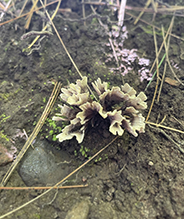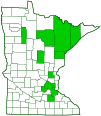Stinking Earthfan
(Thelephora palmata)
Conservation • Description • Habitat • Ecology • Distribution • Taxonomy
Conservation Status |
|
|||||||
| IUCN Red List | not listed |
|||||||
| NatureServe | NNR - Unranked |
|||||||
| Minnesota | not listed |
|||||||
Description |
||
Stinking Earthfan is a widespread, coral-like mushroom. It occurs in Europe, Asia, Australia, and North America. In the United States it occurs in the east from New Hampshire to North Carolina, west to Minnesota and eastern Texas. In the west it occurs west of the Rocky Mountains from Northern Washington to Central California. It is not uncommon, but it is often overlooked due to its drab brown color and irregular shape blending into its surroundings. It is found in summer and fall, in coniferous and mixed forests, also in grassy fields, alone or in groups but not clustered (gregarious). It grows on moist ground under or near coniferous trees. It has a mutually beneficial relationship (mycorrhizal) with the tiny rootlets of trees, absorbing sugars and amino acids while helping the tree absorb water. The fruiting body is a 1¼″ to 4″ (3 to 10 cm) high, 1½″ to 4″ (4 to 10 cm) wide, coral-like tuft of many branches rising from a common, stalk-like base. The branches are erect, cylinder-shaped, whitish, and hairless at first. As they age, they flatten out and darken. Mature branches are dark gray, dark brown, or purplish-brown, flattened, and widened toward the top, palm-like. This is the feature that gives the fungus its species epithet. They are usually paler or whitish at the still-growing tips. The surface is slightly wrinkled. The base is ¾″ to 1¼″ (2 to 3 cm) high, up to 3⁄16″ (5 mm) thick, and dark gray to black. The flesh is tough, leathery or corky, and brownish to whitish. It has a strong garlic-like odor when young, becoming foul-smelling with age. It does not change color when sliced. The edibility is unknown, but the foul odor will deter most. |
||
Similar Species |
||
| Thelephora anthocephala has a short but distinct stem. It does not have a strong odor. |
||
Habitat and Hosts |
||
Coniferous and mixed forests, grassy fields |
||
Ecology |
||
Season |
||
Summer and fall |
||
Distribution |
||||
|
Sources |
|||
| 2/18/2023 | ||||
Occurrence |
||||
Widespread and not uncommon |
||||
Taxonomy |
|||
| Kingdom | Fungi (fungi) | ||
| Subkingdom | Dikarya | ||
| Phylum | Basidiomycota (club fungi) | ||
| Subphylum | Agaricomycotina (jelly fungi, yeasts, and mushrooms) | ||
| Class | Agaricomycetes (mushrooms, bracket fungi, puffballs, and allies) |
||
Order |
Thelephorales | ||
Family |
Thelephoraceae | ||
Genus |
Thelephora | ||
Synonyms |
|||
Clavaria palmata Clavaria schaefferi Merisma foetidum Merisma palmatum Phylacteria palmata Ramaria palmata |
|||
Common Names |
|||
Fetid False Coral Stinking Earthfan |
|||
Glossary
Mycorrhizal
A symbiotic, usually beneficial relationship between a fungus and the tiny rootlets of a plant, usually a tree.
Visitor Photos |
|||||
Share your photo of this fungus. |
|||||
| This button not working for you? Simply email us at info@MinnesotaSeasons.com. Attach one or more photos and, if you like, a caption. |
|||||
Honey Fae (Farah) |
|||||
 |
|||||
MinnesotaSeasons.com Photos |
|||||
|
|||||

Slideshows |
||

Visitor Videos |
|||
Share your video of this fungus. |
|||
| This button not working for you? Simply email us at info@MinnesotaSeasons.com. Attach a video, a YouTube link, or a cloud storage link. |
|||
Other Videos |
|||
| Thelephora palmata (Scop.) Fr. čes. plesňák zápašný Encyklopedie hub |
|||
About
Oct 24, 2020 Česká republika, Vendolí |
|||
| Thelephora anthocephala The wonderful world of mycology |
|||
About
Sep 20, 2018 Thelephora anthocephala (Bull.) Fr. 1838 |
|||

Created: 2/18/2023
Last Updated:


